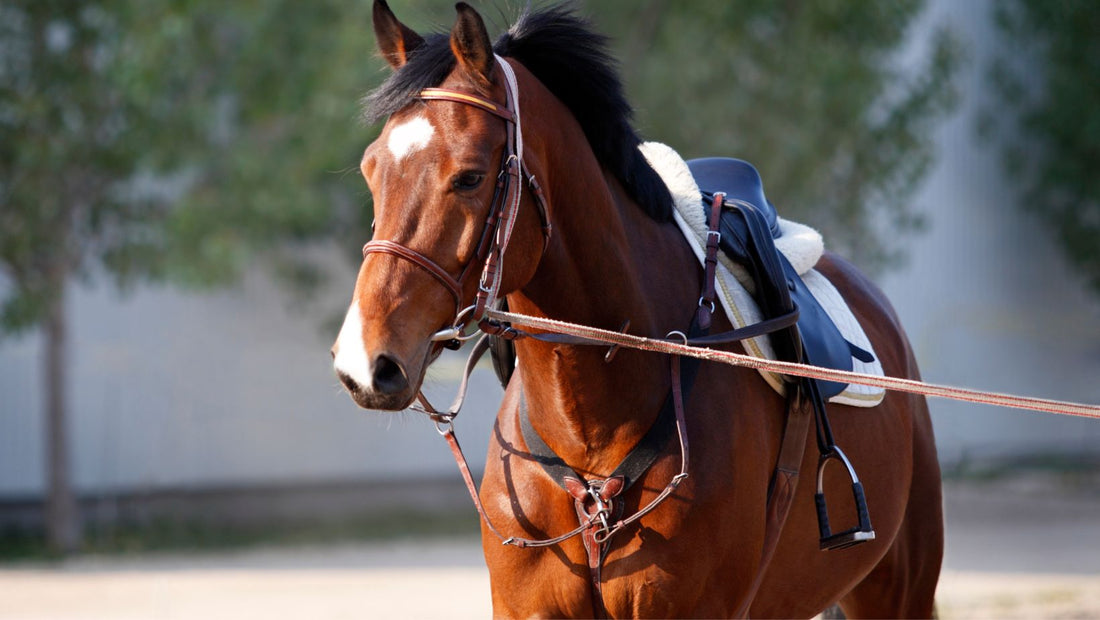
How to Lunge a Horse (Tips and Techniques)
Michelle DrumLunging is one of the best exercises for horses and riders, whether you’re an experienced equestrian or a beginner. From strengthening your bond to providing positive mental stimulation, the value a regular lunging routine brings can be hugely beneficial. Riders who regularly lunge their horses typically see a great improvement in their horse’s overall performance and well-being. In this post, we’ll share the equipment and techniques you’ll need in order to start lunge training your horse.
What is lunging?
Lunging a horse is a training technique where the horse is asked to move in a circle around a rider. The rider holds a lunge line attached to the horse’s bridle to keep them in place and uses a lunge whip to direct the horse’s movement.
Lunging is often used as a starting point while working toward breaking a young horse. It can be used to familiarize the young horse with the weight of the equipment, learn to move with tack on, wear a bridle and bit, and understand early training commands. Lunging can also be used as a warm-up exercise, as part of a training program to develop the horse’s fitness and balance, or as a way to assess the horse’s movement and gait. The person lunging the horse can also use various exercises, such as transitions between gaits and work over ground poles, to further challenge the horse and improve their training. A proper lunging technique is important to ensure the safety of both the horse and the rider or trainer.
What are the benefits of lunging a horse?
Lunging exercises are one of the best ways to strengthen the relationship between you and your horse, expend energy for spirited horses, and warm up the muscles of older horses before a ride.
Overall, lunge training is a versatile and effective training tool that can benefit horses of all ages and experience levels. Here are a few major benefits of lunge training.
- Improves fitness. Lunge training is an excellent way to improve a horse’s fitness level. By working in a circle at various gaits, the horse can increase cardiovascular endurance and develop stronger muscles.
- Develops balance and coordination. Lunging helps to improve a horse’s balance and coordination by encouraging them to maintain their balance while moving in a circle. This can be particularly beneficial for young or inexperienced horses that are still learning how to carry a rider and maintain balance.
- Enhances suppleness. Lunging can help to improve a horse’s suppleness and flexibility by encouraging them to stretch their muscles and move through their full range of motion.
- Provides mental stimulation. Lunging can be mentally stimulating for high-energy horses, particularly when various exercises are introduced. Incorporating ground poles or transitions between gaits can keep the horse engaged and interested in the training process.
- Helps assess movement. Lunging is a useful tool for assessing a horse’s movement and identifying areas of weakness or stiffness. This can be particularly beneficial for horses recovering from an injury or those with physical limitations.
What you need to lunge a horse
You’ll need the following things to begin lunging with your horse.
Tack and equipment
Lunging requires specific equipment for your horse, starting with a lunge line, a lunge whip, and a bridle or lunging cavesson. Some riders opt to use leg wraps on their horse to help prevent injury. While lunging, riders typically wear riding boots or other sturdy boots, an ASTM/SEI-approved riding helmet, and gloves to help protect against rope burn.
Suitable location
Find a quiet, enclosed space to lunge your horse, typically a pen or arena with a flat surface. Make sure the location is free from debris, obstacles, or holes that your horse might trip on. If you and your horse are both new to lunging, pick a place without other riders so you can both focus on the task at hand.
Healthy horse
You shouldn’t try to lunge train an injured, stressed, or otherwise unhealthy horse. Lunging requires focus and for both horse and rider to be focused and in top shape. A good diet is key to keeping your horse healthy but that’s just the start. Taking care of your horse year round, through summer and winter, ensures they stay in supreme condition.
How to teach a horse to lunge
Follow these steps to teach your horse how to lunge properly. Make sure this process becomes a ritual so you and your horse can both get used to the lunging sessions.
Before lunging a horse, make sure the horse is sound, in good health, and physically ready for exercise. Check your horse’s legs and hooves for any signs of injury or lameness and ensure the horse is properly warmed up.
1. Arrive at the lunge space
You should have an established place where you and your horse have lunge training. Select an area that is flat, well-lit, and free of obstacles. It should be large enough to allow the horse to move freely in a circle without running into anything. Make sure the footing is firm and even so both you and your horse don’t slip.
Introduce your horse to the space if it’s new; otherwise, familiarize your horse with the lunge equipment you’ll be using. Hold the lunge line loosely and let the horse sniff and investigate it. Then, introduce the whip, holding it in your hand and tapping it lightly on the ground or the horse’s shoulder. Make sure the horse is comfortable with the equipment before starting the lunging session.
2. Tack Up
Tack up the horse in a halter, bridle, or lunging cavesson, and attach the lunge line to the horse’s headgear. Wrap the line in big loops in your hand so you can let the line out easily and protect yourself in case the horse bolts unexpectedly. Make sure both you and your horse are comfortable with the tack and equipment before proceeding. We recommend practicing with the lunge whip by yourself if you haven’t used one before.
Learn more: How to Tack Up a Horse
3. Get into position
Walk the horse to the edge of the paddock or other enclosure and slowly back away, letting out the lunge line as you do so. Keep a bit of slack in the lunge line so the horse isn’t pulled toward you, but don’t let the line drag the ground.
Visualize that you and your horse are making a triangle: the horse is the base of the triangle, the rope and whip are the sides, and you are the topmost point. If the horse is working to the left, keep your lunge line in the left hand and whip in the right, changing the order when the horse starts working to the right.
4. Start basic lunging
Stand in the center of the circle and ask the horse to move forward in a circle around you. Most experts recommend starting with a counter-clockwise circle and changing directions once the horse is comfortable. With gentle touches, use the whip to guide the horse forward; the whip takes the place of your leg in this instance, encouraging the horse to move forward and maintain its gait.
Use a voice command to urge the horse to begin walking, using a gentle flick of the lunge whip against the horse’s rear if necessary. Complete a few walking laps to warm up and make sure the horse understands what you expect.
5. Begin upward and downward transitions
Once you feel confident to proceed, you can work on upward and downward transitions with your horse. Use another voice command to increase to a trot and, eventually, a canter. Practice asking your horse to decrease in speed as well, using the applicable voice commands. A low, drawn-out “whoa” is typically used to ask the horse to halt.
Reward the horse with praise and treats for good behavior during this entire process. This will help to reinforce positive associations with the training process and encourage the horse to continue to learn and improve.
How often should you lunge train your horse?
Lunge training sessions are both physically and mentally taxing for horses. These sessions should last about thirty to forty-five minutes, though never longer than an hour. What’s more important is that lunge sessions should be fairly frequent, depending on your horse’s ability and your training schedule. High-energy or inexperienced horses should be lunged more frequently than older horses, about 3-4 times a week. Once or twice a week is more than enough for more mature horses.
Lunging is a fantastic exercise that helps build trust and improves communication between horse and rider. It also improves the horse’s strength and suppleness to aid performance in dressage training and competitions. With any training program, it’s important to take a gradual and systematic approach and to always pay attention to the horse’s comfort and well-being. Once you’ve got the technique down, your bond will be stronger and riding sessions are sure to improve.
Regular exercise and training are just one of the many ways to keep your horse healthy and happy.
Explore our full collection of staff-tested lunging equipment. If you have questions about any of our products, give us a call at 864-457-3557. We’re happy to help!
You might also like:
